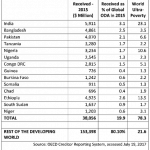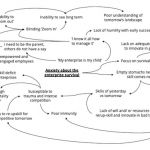Weekly Roundup: Foundation Under Fire, Hartigan Remembered and Blockchain Unchained
In the name of political expediency – and in the face of mounting criticism – the Clinton Foundation announced Thursday that it won’t take foreign and corporate money and Bill Clinton will resign from the board if Hillary Clinton is elected president Nov. 8.
The announcement came two days after a Boston Globe editorial cited the foundation as an “inherent conflict of interest,” called for it to stop accepting all funding and, if Clinton’s elected, to shut down entirely. That story came on the heels of Ed Rendell, a Clinton friend and former chairman of the Democratic National Committee, telling the New York Daily News, “I definitely think if she wins the presidency they have to disband it. … It’d be impossible to keep the foundation open without at least the appearance of a problem.” There were also troubling emails and a blunt CNN story on Wednesday detailing a mingling of political and foundation business.
Politically, in the interest of the candidate’s trust ratings, something had to be done. It’s not clear if the relatively benign actions taken Thursday will be enough to dim the media spotlight and appease those who have, for years, attempted to connect Clinton’s actions as a public official to foundation contributions. It’s fair to wonder if more drastic actions might be in store for the foundation.
Which leads to another, strangely overlooked angle in the story. The foundation, which started in 2001 after Bill Clinton’s presidential terms expired, has raised more than $2 billion and done impressive work over the years in global health, climate change and increasing opportunities for girls and women, and all those in poverty around the world. Will politics shut down an organization that’s done so much good and still has such huge potential, ethical issues notwithstanding? Is it even possible to quickly shut the doors on a foundation so large? What would that look like?
The Boston Globe editorial has some ideas: “Winding down the foundation, and transferring its assets to some other established charity, doesn’t have to hurt charitable efforts. If the foundation’s donors are truly motivated by altruism, and not by the lure of access to the Clintons, then surely they can find other ways to support the foundation’s goals.”
It’s become a debate – a very worthwhile debate – about power and priorities. Unfortunately, and as usual, those who are ultimately most impacted are being left sitting on the sidelines with no role to play.
– Kyle Poplin
Remembering Hartigan
NextBillion would like to add our condolences to the family, friends and colleagues of social entrepreneurship pioneer Pamela Hartigan, who died last week. Hartigan was the first managing director of the Schwab Foundation for Social Entrepreneurship, serving from 2000 until she left in 2008. She left the organization to teach at Oxford University’s Saïd Business School and led the Skoll Center in Oxford. She also served as managing director of the World Economic Forum.
Last year, Hartigan was mentioned in another NB weekly Roundup when, in a speech, she issued a challenge not to “dichotomise the commercial and the social spheres,” noting:
“Social entrepreneurship is not a field – it is an approach, a mindset, a way that you address a problem. This mindset and approach can be defined as an ability to combine innovation, opportunity and resourcefulness to shape and evolve a solution to a very specific problem.”
The Skoll Center posted this tribute:
– Scott Anderson
From blockchain to impact measurement: two new reports
Few people understand it, and even fewer can explain how it works, but blockchain technology continues its march toward the development sector mainstream. On Aug. 11, the World Economic Forum (WEF) released “The future of financial infrastructure: An ambitious look at how blockchain can reshape financial services,” a 300-page report exploring how the financial sector can use the innovative distributed ledger technology to “reshape financial services.” Here’s a brief rundown of its findings.
Meanwhile, The Global Impact Investing Network (GIIN) came out with a new report of its own this week. “The Business Value of Impact Measurement” explores different ways that “impact investors and investees use impact measurement practices to inform investment and management decisions to drive business value.” Based on interviews with 30 practitioners from a range of organization types, geographies, and asset classes, it highlights specific examples of investors and investees that are doing this successfully, and identifies “five key drivers of business value that are derived from the application of impact measurement and management.” Here’s a summary of some key findings.
– James Militzer
Everyone talks about ‘rigorous research’ – so why aren’t they using it?
Here are some surprising numbers: 68 percent of third-sector organizations trust university research. Yet just 35 percent frequently use it.
Those are among the results in a Carnegie UK Trust report released this spring, and flagged this week on the Oxfam blog. It found that among third-sector organizations in the UK, including everything from charities and NGOs to social enterprises, university research is the most trusted but one of the least-used sources of evidence. Instead, as the report puts it, “Evidence tended to be gleaned from the internet and the media, even though these sources were much less trusted.”
In a sector where rigorous research is highly touted, why are organizations so reluctant to use it? The report highlights “a need for ‘knowledge brokers’ … to synthesise and transform evidence into an effective and usable form for policy and practice, through a process akin to alchemy.” It also mentions the fact that “people and small businesses outside universities find them impenetrable institutions,” often encountering “a huge, incomprehensible organisation whose website is structured according to supply-side logic (faculties, departments, degree programmes) rather than according to demand considerations or user needs.” Translation: The two sides are speaking different languages. The report explores some solutions to this impasse – it’s definitely worth a read.
– James Militzer
Bloomberg takes on a tall order
In other development/politics news, Michael Bloomberg, the former three-term New York City mayor who toyed with the idea of running for president – and then became the target of Trump tweets about his stature – was named WHO’s global ambassador for noncommunicable diseases (NCDs).
It’s not that the position comes with lots of power – it’s purely honorary and unpaid – it’s just that Bloomberg is highly motivated to battle NCDs, which cause 80 percent of deaths worldwide but get only 2 percent of health funding. Bloomberg’s a former smoker turned anti-smoking activist who tried to look out for the health of New Yorkers when he was in office, leading fights against public smoking, trans fats and large sodas. He also has a long record of supporting WHO.
His new role is expansive; the plan is for him to help reduce “tobacco use, unhealthy diet, physical inactivity and the harmful use of alcohol, as well as to promote proven measures to reduce injuries from road traffic crashes, burns, falls and drowning.” That’s a tall order (no pun intended), but he seems to be a great choice.
– Kyle Poplin
IN CASE YOU MISSED IT … THIS WEEK ON NEXTBILLION
NexThought Monday: Borrowing and Saving – Not Two Sides of the Same Coin
Svadha: ‘The First Step for Households Is to Get a Dignified Toilet and Use It’
Impact Investing Comes of Age: ImpactAlpha Rounds up Nine Stories Shaping the Marketplace
A Demographic Time Bomb: The Urgent Need to Prepare Undocumented Hispanic Immigrants for Retirement
Is Ultra Poverty Graduation Working?
Photo by Kelly DeLay via Flickr.
Homepage photo: Jill /Blue Moonbeam Studio, via Flickr.
- Categories
- Health Care, Technology
- Tags
- blockchain, research



